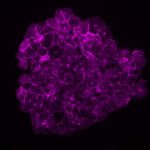Link to Pubmed [PMID] – 20696894
Link to DOI – 10.1073/pnas.1001045107
Proc Natl Acad Sci U S A 2010 Aug; 107(34): 15117-22
Dynamic changes in gene positioning contribute to differential expression of virulence-related gene families in protozoan pathogens; however, the role of nuclear architecture in gene expression in the human malaria parasite Plasmodium falciparum remains poorly understood. Here we investigated the developmentally regulated ribosomal RNA (rRNA) gene family in P. falciparum, which, unlike that in most eukaryotes, contains only a few unlinked copies of rRNA genes scattered over the subtelomeric regions of several chromosomes. We show that active and silent members of this gene family cluster in a single perinuclear nucleolus. This rDNA nuclear confinement is DNA sequence dependent, as plasmids carrying rDNA fragments are targeted to the nucleolus. Likewise, insertion of an rDNA sequence into a subtelomere from a chromosome lacking rRNA genes leads to repositioning in the nucleolus. Furthermore, we observed that rDNA spatial organization restricted interchromosomal interactions, as chromosome end-bearing rRNA genes were found to be preferentially juxtaposed, demonstrating nonrandom association of telomeres. Using Br-UTP incorporation, we observed two alpha-amanitin-resistant nucleolar transcription sites that disappeared when the rDNA cluster broke up in the replicative blood stages. Taken together, our results provide conceptual insights into functionally differentiated nuclear territories and their role in gene expression in malaria parasites.


